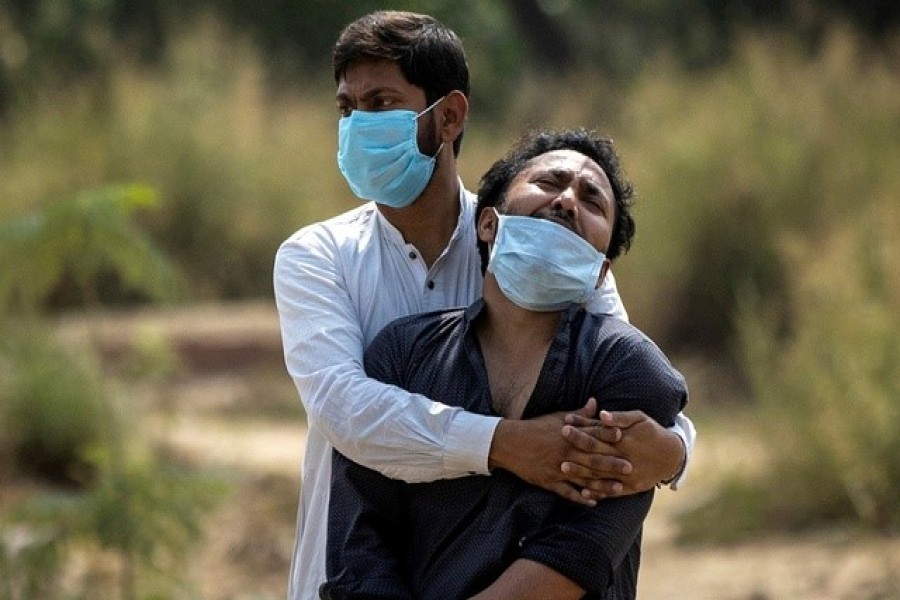Covering the second wave of the coronavirus pandemic as it tore through Indian cities, towns and villages was overwhelming at times.
Patients died at home, in their cars on the way to hospital and outside emergency wards because there were no beds for them.
India has recorded more than 28 million coronavirus cases, and daily new cases sometimes exceeded 400,000, although by Thursday, June 3, that had come down to around 135,000.
On a per capita basis its Covid-19 death toll is relatively low, but deaths were rising while in Europe and the United States they are in decline.
Some Indians said what made the devastation of April and May harder to accept was that they believed the worst of the pandemic was over in February, when the number of Covid-19 cases and deaths were far below today's.
In the middle of that month, the number of daily new cases was around 9,000.
Election rallies went ahead, markets teemed with people and huge crowds of worshippers attended religious festivals. In much of the rest of the world, large gatherings were forbidden as governments fought to slow the spread of the virus.
Prime Minister Narendra Modi resisted calls for a repeat of the strict lockdown he ordered last year. Instead he asked states to impose local curbs in the worst affected areas.
The health ministry did not respond to a request for comment on the government's Covid policies.
In April, I travelled to Haridwar, a holy Hindu city along the river Ganges, to cover the Kumbh Mela, a festival where people believe that bathing brings salvation from the cycle of life and death. Millions of devotees showed up.
My trip to Lok Nayak Jai Prakash Narayan Hospital in New Delhi later that month came as a shock. I had been to the same hospital - the largest in the capital - a few months back, and at that time things were organised and under control.
This time, as I stepped into the emergency room, it was different.
There were scenes of chaos. Gasping for air, two men wearing oxygen masks shared a bed. People struggled to get oxygen and the attention of medics, themselves overwhelmed with the number of new patients.
Some relatives pleaded with me to diagnose their loved one, mistaking me for a doctor because I was wearing PPE gear. Others who saw my camera urged me to document the pain their family was suffering.
"We are definitely overburdened," Suresh Kumar, the hospital's medical director, told me at the time, as dozens of new patients arrived. "We are already working at the full capacity, (or) rather double of the capacity."
Since my April visit, the emergency has eased.
Kumar said this week hospital admissions had fallen from around 200 per day at the peak of the second wave to single digits, although the intensive care unit remained full as patients stayed in hospital for longer periods of time.
"We are more comfortable with the oxygen supply, we have enough drugs, we have better infrastructure, we have more ICU beds, we have more trained manpower and now we can handle any future wave," Kumar told Reuters by telephone.
Holy Family Hospital, another hospital in the Indian capital, where I documented a 27-hour workday shift of a junior doctor in early May, did not respond to a request for comment this week on its current situation.
INVISIBLE ENEMY
At graveyards and crematoriums, the scenes were grim.
Mass cremations took place in crematorium parking lots to cope with the number of bodies, and the intense heat the pyres generated sometimes prevented me from getting close to take photographs and video.
At graveyards, multiple burials were held at the same time. On several occasions I put down my cameras to attend prayers, as I knew the victims being buried that day. I only found out about their deaths when I met common acquaintances there.
I also visited rural areas, where some hospitals were close to collapsing under the number of patients seeking treatment for Covid-19.
At the emergency ward of Bijnor Government Hospital, four people with breathing difficulties died in front of me in less than an hour.
"There is no doubt about it, the number of infected persons is quite large," Ramakant Pandey, the top district official in Bijnor, told me on the day of my visit.
Manoj Sen, the medical superintendent of the hospital, this week said case numbers had fallen drastically.
"At that time we were not expecting the number of cases and we were also not prepared," he said. "There was a shortage of oxygen and manpower both. But now we are prepared well."
Some victims and their families stood out vividly.
Outside a mortuary, a brother and sister dressed in identical blue uniforms of the bank where they worked consoled their mother after their father died.
At a graveyard, a young man wailed as he begged his recently deceased father for forgiveness, believing it was he who had given him the virus.
The pandemic has also brought out the best in people.
Indians I have covered are doing extraordinary things, be it a 26-year-old doctor battling to save lives, or teams of Sikh volunteers dispensing free oxygen to people desperate to keep loved ones alive.
I have been a journalist for almost 14 years, witnessing tragedies around the globe.
But I never thought I would see misery and death on this scale in New Delhi, the city I grew up in. At the height of the Covid-19 surge in May, 448 people in the city died from the disease in a single day.
This is a battle with an invisible enemy, and it feels like there is nowhere to hide.


